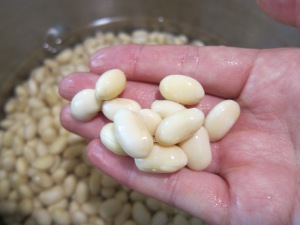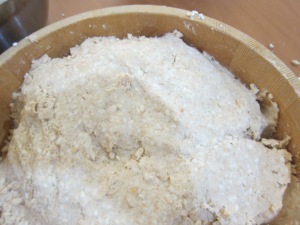Have you ever think about what is Miso paste?
Miso paste is fermented soy bean paste and it’s one of the most important seasonings in Japan.
What is Miso ? How to make miso paste? http://en.wikipedia.org/wiki/Miso
There’re so many kinds of Miso paste recipe here, it depends on the region, family, ingredients, age etc.. (like your cheese!)
We usually buy them from market since it takes time to make, or I guess not many people know how to make it from scratch nowadays.
I first time made it from scratch 2 years ago, I had been waiting for 1 year until it fermented enough, and it turned out great!
Preparing aged Miso is easy, and with patience and time, develops a cultured rich flavor that explains why it is one of the most popular fermented seasoning in Asian cuisine.
It’s not difficult to make and so good taste, so please try it if you Love Japanese food including Miso flavor :)!
Ingredients:
-1.2 kg of soy beans
-1kg of Rice Koji
(What is Koji? http://en.wikipedia.org/wiki/Aspergillus_oryzae)
-450g of salt (if you live in hot weather place, or make it in spring/summer, please use it 500g)

(salt, Rice Koji, soy beans)
If you make Home made Miso, I suggest you to prepare natural salt (not NaCl), and good ingredients 🙂
1. Soak the soy beans overnight. (at least 18 hours)
After you soak it enough..
2. Cook the soy beans with pressure pan for 20 minutes. If you use regular pan, cook for about 4 hours.
3. After you cook the beans, cool it down a little bit and Mash them with your hands during it’s still warm/hot.
Please don’t use blender or food processor since you would not have good texture/ flavor. (it become smooth paste)
4. Mix Rice Koji and salt well.
5. Add the mashed soy beans and mix all of them well.
6. Make balls. (When you pack them in a jar, it’s easier and better to do that and also it’s less air between the Miso paste)
7. Pack the Miso balls in a jar and press down firmly. Make the surface flat and spread salt.
8. Cover the surface with a flat object on top and put the weight on top of that.
9. Place a heavy weight on top. Ferment for one year in a room temperature/cool place in the house. (not in the fridge)
You can get more good Miso paste if you make it in autumn or winter. If you live in hot weather place or make it in spring or summer, ferment for 4-6 months.











WOW! Great post! and I can vouch this is a pretty authentic recipe 🙂
Thank you so much for your comment. Miso is one of the Japanese traditional basics. You can understand the history of Japanese food by making this. and the taste is amazing!
How is it best kept and for how long after fermentation?
having little stackable dishes would help make a little for every month or different kinds.
I have heard a lot about Miso Soup.
But never thought making the paste was this easy, thank you.
Making me hungry.
fried noodles today.
It’s my pleasure! you can keep the jar in room temperature, please check it every few month if it’s ok 🙂 the duration is depends on the weather. home made miso is very deep flavor, so nice, please try small portion first 🙂
Hi, just discovered what koji was today, so very interesting to see this recipe 🙂 I have a question though : You really need to ferment this for one year (!) before you can consume it? thanks!
Depends on how it is fermented, you can start to eat 6 months-12 months fermentation. You need to use them up before 2 years fermentation. Enjoy!
Wow, never realized making miso paste required such few ingredients and so much time! I would love to try making this, but I don’t know if I can be patient enough to wait for the paste to ferment for that long haha. Thanks for sharing! 😀
Recently, even Japanese people don’t usually make miso by themselves. The tradition is becoming to be forget sadly. Please try this and succeed Japanese tradition!! 🙂
Thank you for this recipe! I never thought of making my own.
Thank you so much for your comment! It is easy and tasty. Please try it once. I ensure the wonderful result.
How can I use this to make a vegetarian miso soup? (without dashi of course)
The hand made miso has the stronger taste than you can buy. And the longer miso is fermented, the deeper the taste of miso become. So you can cook Miso soup only with this miso and add some vegetables you like.
Besides, you may use Shiitake for dashi if you need.
Mari,
I’m glad that I’ve found your post when looking for ways to make 金山寺miso. Would it be an easy modification from this recipe? It seems from your suggestion that I need to get started soon, before the winter’s over. It all started from a casual search. Sigh… 🙂
Take care,
Jean
hi Jean, thank you for your comment! I’ve never heard of 金山寺miso before, which region is it? do you like it?
yes, you should try in winter if you make, you would be surprised with the rich flavor 🙂
Hi Mari,
We first tried 金山寺miso in Tokyo. We liked it so much that we brought some back to the US.
According to the following reference, it’s a specialty of the 和歌山県 area:
http://ja.wikipedia.org/wiki/%E9%87%91%E5%B1%B1%E5%AF%BA%E5%91%B3%E5%99%8C
It looks like I need to get busy now. 🙂
Take care,
Jean
Hi Jean, Thank you for your comment! I’ve never had it before, but it looks so good! I think you don’t need much time to make it compared to making Miso, since this one is more fresh/more Koji so you don’t need to frament for long time. It must be good with Sake or rice!
Konichi wa, Mari, arigato gozaimasu for your kind comment on my article, ferments heal radiation sickness. And thank you for your article about how to make miso. I will become a follower of your weblog. I am happy to know you are promoting traditional Japanese cooking. When I was a child in New York more than fifty years ago I had several Japanese friends. My Japanese friends taught me to read and write and speak Japanese. Because of the radiation from Fukushima I am encouraging the people of Alaska to make barley miso. We Alaskans do grow our own barley. I would be so grateful to see your recipe for barley miso. With gratitude, Lindianne
Kon nichi wa, Arigato so much for your warm comment. I used to work as a nurse for Uni. Hospital and I read some article about Miso is very good for removing radiation. I heard Chernobyl imported many Red Miso after the accident too. I’m so jealous that you have your own barley- it must be very tasty Miso paste you can make 🙂 Thank you again for your message and hope you have tasty healthy life with Good foods!
Hi I wanted thank you for following my blog. I am following yours .I love Japanese Cooking. I love other countries too but I am use to seeing more of Japanese cooking. It is like art and so beautiful . .Keep up the great work:)
Twittehank you for your comment!
Looking forward to see your blog, too 🙂
Thanks right now I have to wait to upgrade because I ran out of space . I am working on it 😉
My first batch of miso only filled my crock about 30%. Can I make another batch about a week later and layer it in the same crock?
If it’s only one week then I think you can just mix the new one together, but if there’re some time between them then it’s better to use new batch I think 🙂
Can I layer batches of miso (the same recipe) in the same crock?
Hi,
Can I use normal rice instead of koji,
Because koji is not available in India ?
Thanks
Hi Rahul,
You can’t make it without Koji, since it’s like yeast for the bread.
I guess you might find it on the internet?
I have been making miso for thirty years at home I have some vintage 24 year old which I have kept sealed in the refrigerator after first year fermentation … this batch is my seed miso that I add a little to each new batch to introduce the salt resistant lactobacillus. BTW it tastes just AMAZING so it is very hard not to eat it up.
Vintage 24 year old!? It’s first time to hear that and I really want to try some! It would be wonderful!Thank you so much for sharing about your Miso and I want to make some vintage too..
Hello Mari,
I am a kelp seaweed harvester living on the west coast of Canada, Cortes Island, BC. As Kombu kelp is the traditional condiment for Japanese Miso soup I would like to know if there would be an equivalent amount of raw “sea salted” kelp that you would use in the fermentation process if you where to substitute the wild harvested kelp for the amount of salt used for the recipe? I wish to promote this beautiful traditional product on our homefront.
Hi Blair,
Thank you for your comment! What a great job you have, it sounds really nice 🙂
I’m sorry that I don’t know so much about the harvest, but I heard some area, especially in Hokkaido, all the school/company close on the kelp season because everyone pick up the kelp from the sea by hand one by one, and dry them under the sun. so it’s not like framentation. (we have aged kelp though)
Sorry that it doesn’t help you so much, but hope everything is going well with you and I wanna try Canadian kelp, too!